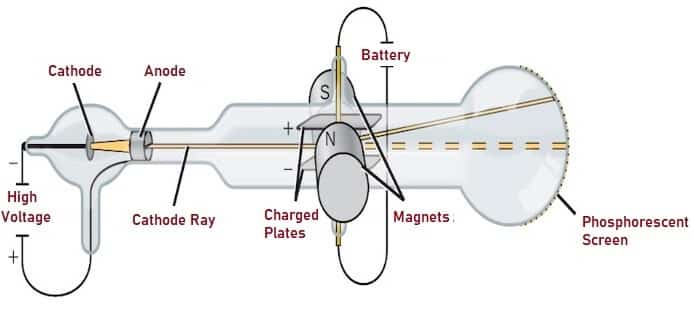
I have therefore repeated Perrin's experiment in a form which is not open to this objection. Now the supporters of the aetherial theory do not deny that electrified particles are shot off from the cathode they deny, however, that these charged particles have any more to do with the cathode rays than a rifle-ball has with the flash when a rifle is fired.


This experiment proves that something charged with negative electricity is shot off from the cathode, travelling at right angles to it, and that this something is deflected by a magnet it is open, however, to the objection that it does not prove that the cause of the electrification in the electroscope has anything to do with the cathode rays. Perrin found that when the rays passed into the inner cylinder the electroscope received a charge of negative electricity, while no charge went to the electroscope when the rays were deflected by a magnet so as no longer to pass through the hole. These cylinders were closed except for two small holes, one in each cylinder, placed so that the cathode rays could pass through them into the inside of the inner cylinder. This has been proved to be the case by Perrin, who placed in front of a plane cathode two coaxial metallic cylinders which were insulated from each other: the outer of these cylinders was connected with the earth, the inner with a gold-leaf electroscope. If these rays are negatively electrified particles, then when they enter an enclosure they ought to carry into it a charge of negative electricity. The following experiments were made to test some of the consequences of the electrified-particle theory. The electrified-particle theory has for purposes of research a great advantage over the aetherial theory, since it is definite and its consequences can be predicted with the aetherial theory it is impossible to predict what will happen under any given circumstances, as on this theory we are dealing with hitherto unobserved phenomena in the aether, of whose laws we are ignorant. It would seem at first sight that it ought not to be difficult to discriminate between views so different, yet experience shows that this is not the case, as amongst the physicists who have most deeply studied the subject can be found supporters of either theory. The most diverse opinions are held as to these rays according to the almost unanimous opinion of German physicists they are due to some process in the aether to which-inasmuch as in a uniform magnetic field their course is circular and not rectilinear-no phenomenon hitherto observed is analogous: another view of these rays is that, so far from being wholly aetherial, they are in fact wholly material, and that they mark the paths of particles of matter charged with negative electricity. The experiments * discussed in this paper were undertaken in the hope of gaining some information as to the nature of the Cathode Rays.


 0 kommentar(er)
0 kommentar(er)
